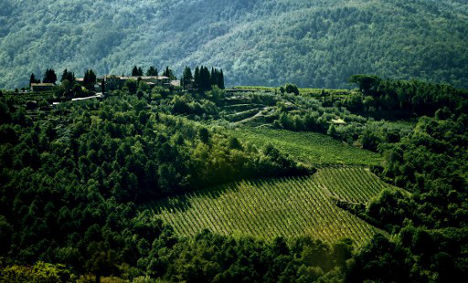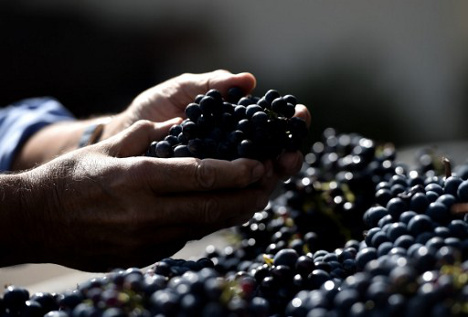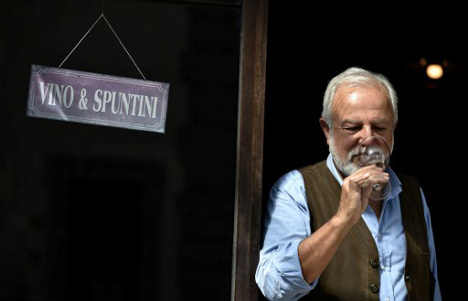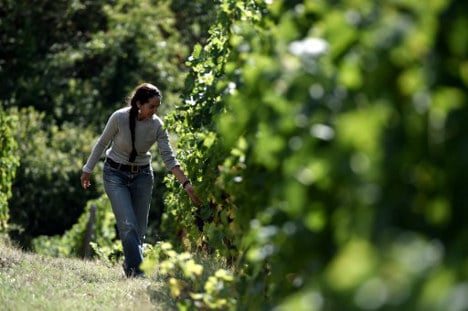The 300-year-old story of what makes Chianti wine so special

The winemakers of Chianti knew they were on to something good when rivals started copying them. By the early 18th century, the sale of counterfeit bottles to ever-thirsty England had become so rife that the local merchant nobles felt compelled to act.
Three hundred years ago on Saturday, Cosimo III, Grand Duke of Tuscany, issued a decree declaring that chianti wine could only be produced within a designated area between the Renaissance powerhouses of Florence and Siena.
The world's first legally enforceable wine appellation had been born.
The Medici duke's decree defined an area of 70,000 hectares (175,000 acres) that now produces 35 million bottles a year of chianti classico. Eighty percent of them are exported to some 100 countries and the region's reputation has been on an upward curve since the 1980s, making it a magnet for wine pilgrims.
 Vineyards between Florence and Siena. Photo: Tiziana Fabi/AFP
Vineyards between Florence and Siena. Photo: Tiziana Fabi/AFP
Sipping from a glass of classico riserva in the Enoteca Falorni wine bar and merchant in Greve in Chianti, Diya Khanna says her trip has been an eye-opener.
"In Canada you think of chianti as one type of wine, but if you come here you learn what it's really all about. There is such a variety of styles," the Berlin-based Canadian tells AFP.
"All of the classicos we have tried have had this soft velvety finish, like a smooth song that finishes off at the end really, really nicely."
Brand confusion
Chianti classico producers have long battled confusion among consumers about the difference between their sought-after, geographically restricted wine and the less distinguished simple chianti made in other parts of Tuscany.
Up to 2010, a producer in the heartland area defined by the 1716 decree could produce both. But that practice was banned as part of measures to strengthen the classico brand and its trademark black rooster logo.
 The grapes being prepared. Photo: Tiziana Fabi/AFP
The grapes being prepared. Photo: Tiziana Fabi/AFP
Generally lighter and less expensive, ordinary chianti remains associated for many with the staple candle-holder of 1970s Italian trattorias - a bottle half-wrapped in a straw basket known as a 'fiasco'. It was from a fiasco that the popes of the 16th century enjoyed their chianti.
But the rounded vessel was to become a symbol of the damage done to the region's international image by an export-driven boom in which quality was sometimes sacrificed for quantity.
Rugby-loving winemaker
The idea underlying the 1716 decree was that Tuscany's land and climate had combined serendipitously over centuries with local know-how to guarantee that a wine from chianti would be of a certain style and quality.
Three centuries later, that idea still prevails among the eclectic bunch of characters now producing chianti classico.
But there is also a new emphasis on variations created by particular soils, exposure and altitude - something wine experts refer to as the "terroir" of a particular site.
With his trim beard, gilet and smart suede boots, Marco Mazzoni looks like a gentleman farmer dressed by Giorgio Armani. But the owner of the small Corte di Valle estate outside Greve insists turning sangiovese grapes into attractive wine is no job for city dilettantes.
 Marco Mazzoni samples a glass of chianti classico. Photo: Tiziana Fabi/AFP
Marco Mazzoni samples a glass of chianti classico. Photo: Tiziana Fabi/AFP
"The ground is full of stones and rocks," he says. "The vines have to suffer to grow and thrive. It makes you sweat."
At Querciabella on the other side of the valley, rugby-loving winemaker Manfred Ing's style is more shorts and walking boots as he oversees the harvest of encouragingly plump sangiovese berries: 2016 could be a vintage to remember, he says.
Querciabella is in the vanguard of a push for a shake-up in the rules that would allow classico producers to label their single-vineyard wines as coming from specific micro-zones on the model of Burgundy in France.
Like many of the top Burgundies, Querciabella is farmed organically and according to bio-dynamic principles. Even the use of manure is now eschewed at a property owned by vegan Sebastiano Castiglioni.
"If we want to be still producing chianti here in another 300 years, this is the way to go," says South African-born Ing as he explains how winter crops such as rocket and wild mustard are used to replenish the vineyard soil in the absence of artificial fertilizers.
Pregnant patience
Once the preserve of men, another thing that has changed in 300 years is that some acclaimed chianti classicos are now made by women.
 Susanna Grassi at work on the vineyard. Photo: Tiziana Fabi/AFP
Susanna Grassi at work on the vineyard. Photo: Tiziana Fabi/AFP
"We are a small but growing club," says Susanna Grassi, who gave up the underwear business for wine in 2000 in order to revitalize the family farm.
Grassi's nine-hectare estate, "I Fabbri" ("The Blacksmiths"), goes up to 680 metres (2,230 feet) altitude, close to the limit of where the heat-loving sangiovese will ripen.
Grassi does not have the option of making powerful, structured wine. Instead the emphasis is on elegance and finesse - a trend towards the expression of pure sangiovese that she thinks Tuscany's female winemakers are helping to drive.
"I think women do have a different sensibility when it comes to wine," she tells AFP. "Maybe it is because pregnancy teaches us to wait, knowing that the final result will be "bello" (beautiful)."
Comments
See Also
Three hundred years ago on Saturday, Cosimo III, Grand Duke of Tuscany, issued a decree declaring that chianti wine could only be produced within a designated area between the Renaissance powerhouses of Florence and Siena.
The world's first legally enforceable wine appellation had been born.
The Medici duke's decree defined an area of 70,000 hectares (175,000 acres) that now produces 35 million bottles a year of chianti classico. Eighty percent of them are exported to some 100 countries and the region's reputation has been on an upward curve since the 1980s, making it a magnet for wine pilgrims.
 Vineyards between Florence and Siena. Photo: Tiziana Fabi/AFP
Vineyards between Florence and Siena. Photo: Tiziana Fabi/AFP
Sipping from a glass of classico riserva in the Enoteca Falorni wine bar and merchant in Greve in Chianti, Diya Khanna says her trip has been an eye-opener.
"In Canada you think of chianti as one type of wine, but if you come here you learn what it's really all about. There is such a variety of styles," the Berlin-based Canadian tells AFP.
"All of the classicos we have tried have had this soft velvety finish, like a smooth song that finishes off at the end really, really nicely."
Brand confusion
Chianti classico producers have long battled confusion among consumers about the difference between their sought-after, geographically restricted wine and the less distinguished simple chianti made in other parts of Tuscany.
Up to 2010, a producer in the heartland area defined by the 1716 decree could produce both. But that practice was banned as part of measures to strengthen the classico brand and its trademark black rooster logo.
 The grapes being prepared. Photo: Tiziana Fabi/AFP
The grapes being prepared. Photo: Tiziana Fabi/AFP
Generally lighter and less expensive, ordinary chianti remains associated for many with the staple candle-holder of 1970s Italian trattorias - a bottle half-wrapped in a straw basket known as a 'fiasco'. It was from a fiasco that the popes of the 16th century enjoyed their chianti.
But the rounded vessel was to become a symbol of the damage done to the region's international image by an export-driven boom in which quality was sometimes sacrificed for quantity.
Rugby-loving winemaker
The idea underlying the 1716 decree was that Tuscany's land and climate had combined serendipitously over centuries with local know-how to guarantee that a wine from chianti would be of a certain style and quality.
Three centuries later, that idea still prevails among the eclectic bunch of characters now producing chianti classico.
But there is also a new emphasis on variations created by particular soils, exposure and altitude - something wine experts refer to as the "terroir" of a particular site.
With his trim beard, gilet and smart suede boots, Marco Mazzoni looks like a gentleman farmer dressed by Giorgio Armani. But the owner of the small Corte di Valle estate outside Greve insists turning sangiovese grapes into attractive wine is no job for city dilettantes.
 Marco Mazzoni samples a glass of chianti classico. Photo: Tiziana Fabi/AFP
Marco Mazzoni samples a glass of chianti classico. Photo: Tiziana Fabi/AFP
"The ground is full of stones and rocks," he says. "The vines have to suffer to grow and thrive. It makes you sweat."
At Querciabella on the other side of the valley, rugby-loving winemaker Manfred Ing's style is more shorts and walking boots as he oversees the harvest of encouragingly plump sangiovese berries: 2016 could be a vintage to remember, he says.
Querciabella is in the vanguard of a push for a shake-up in the rules that would allow classico producers to label their single-vineyard wines as coming from specific micro-zones on the model of Burgundy in France.
Like many of the top Burgundies, Querciabella is farmed organically and according to bio-dynamic principles. Even the use of manure is now eschewed at a property owned by vegan Sebastiano Castiglioni.
"If we want to be still producing chianti here in another 300 years, this is the way to go," says South African-born Ing as he explains how winter crops such as rocket and wild mustard are used to replenish the vineyard soil in the absence of artificial fertilizers.
Pregnant patience
Once the preserve of men, another thing that has changed in 300 years is that some acclaimed chianti classicos are now made by women.
 Susanna Grassi at work on the vineyard. Photo: Tiziana Fabi/AFP
Susanna Grassi at work on the vineyard. Photo: Tiziana Fabi/AFP
"We are a small but growing club," says Susanna Grassi, who gave up the underwear business for wine in 2000 in order to revitalize the family farm.
Grassi's nine-hectare estate, "I Fabbri" ("The Blacksmiths"), goes up to 680 metres (2,230 feet) altitude, close to the limit of where the heat-loving sangiovese will ripen.
Grassi does not have the option of making powerful, structured wine. Instead the emphasis is on elegance and finesse - a trend towards the expression of pure sangiovese that she thinks Tuscany's female winemakers are helping to drive.
"I think women do have a different sensibility when it comes to wine," she tells AFP. "Maybe it is because pregnancy teaches us to wait, knowing that the final result will be "bello" (beautiful)."
Join the conversation in our comments section below. Share your own views and experience and if you have a question or suggestion for our journalists then email us at [email protected].
Please keep comments civil, constructive and on topic – and make sure to read our terms of use before getting involved.
Please log in here to leave a comment.